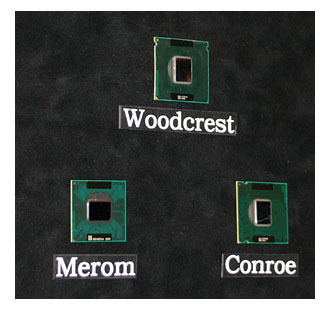IDF wrap-up: Intel is hungry again
San Francisco (CA) - If you are somehow interested in your computer, it's unlikely you missed Intel's announcement fireworks at this Spring IDF. Core, an impressive piece of technology, determined the headlines and will carry Intel through the rest of the decade, we learned. Let's take a step back. What exactly was announced? And what does that all mean? Here's our take.
The Intel developer forum (IDF) typically is the best way to get a deep insight in Intel's product plans for the coming 12 months to 18 months. It's not unusual that visitors see a flurry of announcements, products and trends. But beyond all those press releases, presentations and briefings, IDF always transports a certain message to the audience: This week, we saw an Intel that deemphasized business charts and highlighted a passion for technology instead.
In our preview article "Can IDF relight Intel's fire?" we forecasted that Intel will be focusing on sparking excitement for its products by unveiling a range of new technologies to regain the trust from developers and analysts. Chief technology officer Justin Rattner opened IDF along this route by telling the audience that it will be the most "memorable IDF" that rings in a "truly exciting" time for the company. It wasn't the Intel we have seen in previous years, the change was obvious: "We have been under tremendous competitive pressure and you'd think we've lost some of our enthusiasm," Rattner said. "But that is not true."
That enthusiasm clearly was "Core" and Intel took advantage of every single opportunity to explain its next generation architecture in great detail. And we have to admit, Intel's progress with the new architecture and the first three processors - Merom, Conroe and Woodcrest - is remarkable, considering the trouble Netburst has caused for the company. For now, we are absolutely convinced that Intel has a winner in its hands - a product that will bring the company back on track and drive new innovation in the microprocessor industry.
Let's look a bit closer.
Besides the fact that Intel has renamed NGMA to "Core" - somewhat misleading as the current Core processor is not based on the Core architecture - the technology is pretty much what we expected to see: It will aim not only for performance-per-watt leadership, but also for the performance crown overall. In fact, the performance estimates of increasing performance 20% in the mobile space, 40% on the desktop and 80% on the workstation/volume server, appear to be very conservative estimates: On the one side, Intel cannot afford the embarrassment of missing those marks. On the other, the benchmarks we have seen indicate that an additional 10 percentage points of performance gain and an additional 2-5 points in power improvement for the desktop and server platform is a more realistic estimate.
Intel looks into a brighter future: Chief technology officer Justin Rattner (left), senior vice president Pat Gelsinger
Get Tom's Hardware's best news and in-depth reviews, straight to your inbox.
This huge "leap" already sparked discussions what these new products mean for AMD. Clearly, Intel is out to trump AMD. It is our observation that the Core micro architecture scales better with every added MHz than AMD's Athlons and Opterons. The higher the clock speed of Conroe, the more significant the distance to AMD's current Socket 939 Athlons. The mainstream 65W Conroe is expected to top-out at 2.66 GHz at introduction; an Extreme Edition is expected with 3.33 GHz, which theoretically means that AMD will have to offer the equivalent of an 4+ GHz Socket 939 Athlon to match the fastest Conroe.
AMD, of course, followed Intel's announcements closely. And while the company is as secretive about its future plans as ever, a representative told us that while AMD believes that will "do everything it can to get ahead," AMD "does not believe" at this time that it will have to "react" to the release of Conroe and Woodcrest."
As mentioned in our earlyanalysis, the question how Core will match up with the AMD is the wrong concern anyway - even if Intel has been promoting this comparison with several races between Merom/Conroe/Woodcrest processors and Athlon chips. There is no doubt, Intel has a great architecture on hand that will also motivate AMD to accelerate its product cycles and think about new ways how to create faster and more efficient processors. The earlier Intel can move along with Core, the earlier it can forget headaches caused by Netburst.
In our preview we also forecasted that IDF will see some buzz around the Microsoft Origami, or more generally speaking, the ultra mobile PC. Boy, were we wrong. The UMPC did not get more than two minutes in Intel's public presentations - which we interpreted either as a business decision to provide Microsoft all the launch attention or as an indication that Intel has doubts about the value of the platform.
The first generation of UMPCs isn't pretty and may be hitting some roadblocks
It turned out that Microsoft's Origami is simply a scaled down Windows XP Tablet PC with less features than a mainstream notebook. Yes, it's more portable if you look at the form factor, but its integrated camera can't make up the lack of a keyboard and justify a price of $1000. The first generation of products is clunky, heavy, offers little battery time (about 3.5 hours) and misses the promise Microsoft has made on its mysterious origamiproject.com website. Perhaps the most important downside of the announced UMPCs is connectivity: The devices have integrated Wi-Fi, but that's hardly a feature to advertise these days. The Origami's lack the connectivity one would expect in such a new product - including EVDO/HSDPA, Bluetooth and GPS.
It's our take that Intel won't waste any time promoting the UMPC in this first generation and wait until there is some value in this platform. It's not unusual that Microsoft typical needs three generations to get a product right and it appears that this will be the case with the UMPC as well. Users who are interested in a small and portable Windows PC currently find more mature products either in Motion Computing's Tablet PC series or in the (twice as expensive but more innovative) OQO "ultra" portable computer.
There was a range of more announcements including the release of the LaGrande security specification, new partnerships in virtualization efforts with VMWare and Microsoft, first looks onto the Kentsfield (desktop) and Clovertown (server) quad-core processors, another marketing pitch for Viiv and the "secure" home entertainment network it creates, some updates on the ongoing progress with Wimax, upcoming technologies such as Flash cache - all of which got seemingly lost in the wave of Core announcements and briefings.
The key message of this Spring IDF clearly was that Intel is gearing up for the most important product in the firm's recent history, a product that has the task of boosting the firm's core business - the micro processor. The goal is to trump the competition in all market segment - whatever it takes. The performance claims made at IDF are credible, perhaps even understated. But we maintain a reasonable level of doubt until these claims can be confirmed in the June or July timeframe - when the first production versions of Merom, Conroe and Woodcrest will be leaving Intel's fabs.
A quote of Intel co-founder Robert Noyce was not just directed at IDF visitors. It also promoted a more confident, more excited and more enthusiastic Intel.
It will be interesting to watch what AMD will be offering this year. While we do not know just how capable AMD's products will be with the addition of DDR2 support and the transition to 65 nm in early 2007, it is clear that the company will have to shift into a higher gear to be able to match Intel's power/performance levels. Whether AMD will be able to turbocharge its processors or not, the winner of this competition will be the user: It doesn't take any particular forecasting talent to predict that overall processor performance will have made a huge jump by the end of this year.
And that alone is reason enough to get more excited about microprocessor technologies again.
Tom's Hardware is the leading destination for hardcore computer enthusiasts. We cover everything from processors to 3D printers, single-board computers, SSDs and high-end gaming rigs, empowering readers to make the most of the tech they love, keep up on the latest developments and buy the right gear. Our staff has more than 100 years of combined experience covering news, solving tech problems and reviewing components and systems.




